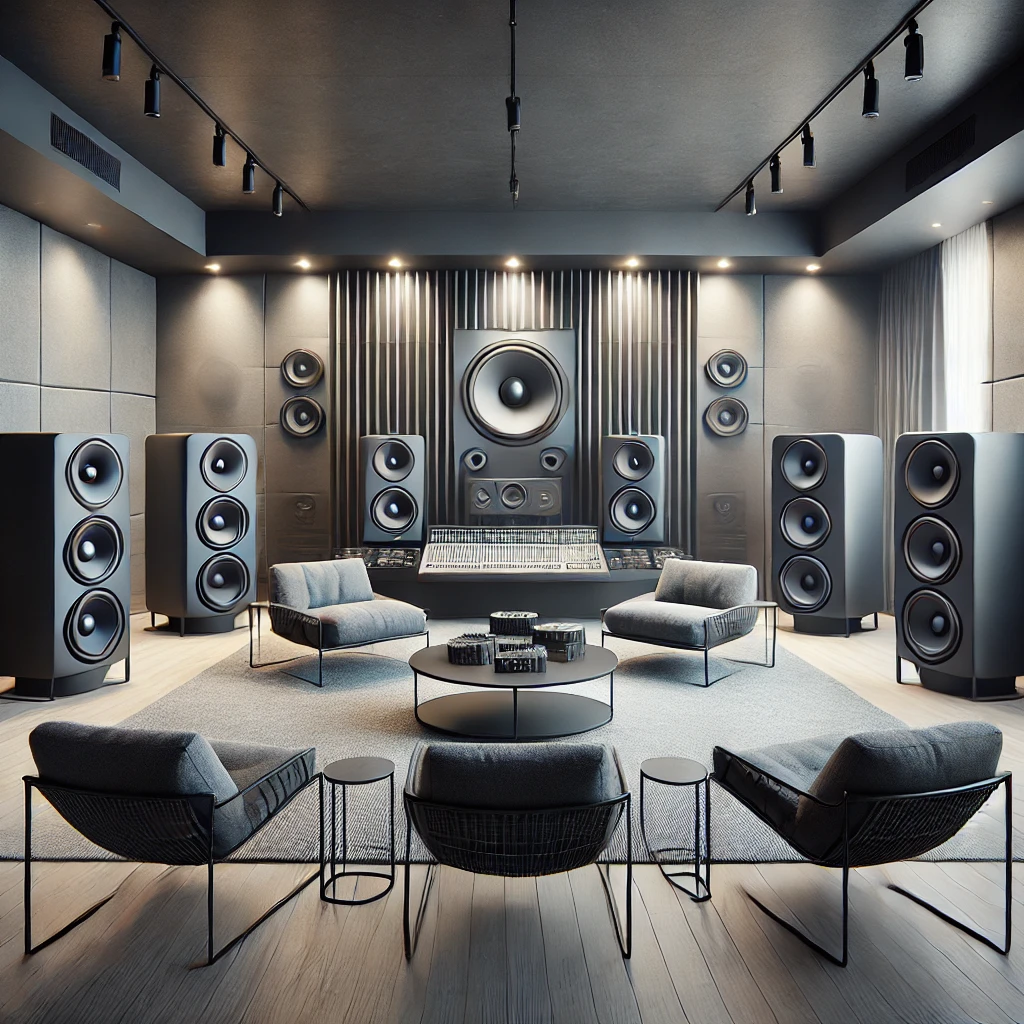Introduction
Sound systems have evolved dramatically over the years, with modern audio setups catering to various applications ranging from small clubs to large concert venues. One of the most effective sound system configurations for ensuring uniform sound distribution in a space is the 4-point sound system design. This setup uses four strategically placed loudspeakers or arrays, providing coverage across a defined area for improved clarity, balance, and immersive audio experience.
In this article, we’ll explore the 4-point sound system in detail, covering its core principles, advantages, typical applications, and the technical aspects of its setup.
Understanding the 4-Point Sound System Design
What Is a 4-Point Sound System?
A 4-point sound system refers to a configuration where four speakers or arrays are positioned at key points around a venue, typically at the corners. The idea behind this layout is to distribute sound evenly across the space, reducing dead zones (areas where sound is weak or muffled) and minimizing the risk of sound overload in any particular location.
This design contrasts with a traditional front-only speaker arrangement, where the sound may become less focused the farther away you move from the front, leading to uneven audio experience for the audience.
Core Principles of the 4-Point Design
The primary aim of a 4-point sound system is to create a balanced sound field by ensuring:
- Uniform coverage: Every corner of the room or venue receives clear and consistent sound.
- Reduction of dead zones: Sound drop-offs are minimized in areas where single-source systems may struggle.
- Immersive experience: The audience feels enveloped by sound, as it’s delivered from multiple directions.
- Volume consistency: The sound pressure level (SPL) is consistent across the space, preventing overly loud or quiet areas.
Speaker Positioning in 4-Point Systems
Proper speaker placement is crucial in achieving optimal performance from a 4-point sound system. Typically, the speakers are mounted at the four corners of the venue, though the exact placement will depend on the specific acoustics of the space.
- Front speakers: These are positioned on either side of the stage or front-facing area, delivering sound directly to the audience.
- Rear speakers: These are placed behind the audience, facing the front, to fill in any gaps in sound coverage.
- Height and angle considerations: To avoid interference or phasing issues, it’s essential to angle the speakers correctly and ensure they are mounted at the proper height relative to the audience’s listening level.
Advantages of the 4-Point Sound System
The 4-point sound system offers several key benefits, especially in larger or more complex environments.
- Enhanced Coverage
With four speakers working together, the system provides even coverage across the venue. This is particularly beneficial for irregularly shaped spaces or open areas where a single-source system might struggle. - Improved Sound Quality
The distributed nature of a 4-point sound system helps prevent excessive sound pressure from building up in specific locations. As a result, the overall sound quality is clearer, with fewer echoes or distortions. - Immersive Listening Experience
The audience enjoys a more immersive experience because sound is coming from multiple directions. This is especially useful for concerts or theatrical productions where the aim is to create a rich, enveloping soundscape. - Flexibility and Scalability
A 4-point sound system can be easily adapted to different venue sizes and applications. For larger venues, additional speakers can be integrated into the system to expand coverage without compromising sound quality.
Key Components of a 4-Point Sound System
To achieve the best performance from a 4-point sound system, it is crucial to understand the key components that make up the system.
1. Loudspeakers
The loudspeakers are the heart of the system. They convert electrical signals into sound and need to be carefully chosen to match the size and acoustics of the venue.
- Full-range speakers: These are typically used in 4-point systems to handle a wide range of frequencies, delivering both high and low-end sounds effectively.
- Subwoofers: For larger spaces or events with heavy bass content (e.g., music festivals), subwoofers may be added to enhance low-frequency performance.
2. Amplifiers
Amplifiers are used to drive the speakers, ensuring they produce the necessary sound levels. The choice of amplifier depends on the power requirements of the speakers and the size of the venue.
3. Signal Processing Equipment
Signal processors such as equalizers and crossovers help manage the audio signals before they reach the speakers. They ensure the right frequencies are sent to the appropriate speakers, optimizing the system’s overall sound quality.
- Equalizers: These help adjust the frequency response to suit the venue’s acoustics.
- Crossovers: These devices split the audio signal into different frequency bands, directing high frequencies to tweeters and low frequencies to subwoofers, improving clarity and efficiency.
4. Mixing Console
A mixing console allows the sound engineer to control the various audio sources (e.g., microphones, instruments) and adjust the sound levels, panning, and effects in real-time.
5. Cables and Connectors
Reliable cables and connectors are critical to ensure stable connections between the components. High-quality cables help prevent signal loss and interference, contributing to the overall reliability of the system.
Setting Up a 4-Point Sound System
Setting up a 4-point sound system requires careful planning and consideration of several technical factors. Here’s a step-by-step guide for a typical setup:
Step 1: Room Analysis
Before placing the speakers, analyze the acoustics of the room. Consider factors such as:
- Room size and shape: Irregular or non-rectangular rooms may require adjustments in speaker placement.
- Wall materials: Reflective surfaces like glass or concrete can cause sound reflections, leading to echoes or reverb. Damping materials or acoustic panels may be needed.
- Audience placement: Ensure the audience is evenly covered by sound, with minimal gaps in the sound field.
Step 2: Positioning the Speakers
Carefully position the speakers at the four corners of the venue. Use the following guidelines for optimal placement:
- Angle the speakers: To avoid phasing issues or interference between speakers, angle them slightly toward the center of the room.
- Height considerations: Mount the speakers at an appropriate height to ensure sound reaches all areas evenly.
Step 3: Fine-Tuning the System
After positioning the speakers, use signal processing equipment (e.g., equalizers, delay units) to fine-tune the system.
- Adjust EQ settings: Tailor the frequency response to match the room’s acoustics, cutting any problematic frequencies that may cause feedback or distortion.
- Use delay compensation: In larger venues, apply delay to the rear speakers to ensure the sound from the front and rear speakers arrives at the audience’s ears simultaneously.
Step 4: Testing and Calibration
Once the system is set up, conduct a sound check to test the coverage and clarity. Walk around the venue and listen for any inconsistencies in volume or clarity. Adjust the speaker positions or EQ settings as necessary to achieve a balanced sound field.
Applications of the 4-Point Sound System
The 4-point sound system design is suitable for a wide range of applications, including:
- Concerts and live music events: Ensures clear and balanced sound for all audience members, regardless of their location.
- Theater productions: Creates an immersive sound experience, enhancing the emotional impact of the performance.
- Nightclubs and dance venues: Provides consistent sound coverage across the dance floor, preventing “hot spots” of excessive volume.
- Corporate events and conferences: Ensures all attendees can hear speeches and presentations clearly, no matter where they are seated.
Conclusion
The 4-point sound system design offers a versatile and effective solution for delivering consistent, high-quality audio in various environments. By distributing sound across multiple speakers, this setup ensures uniform coverage, minimizes dead zones, and creates an immersive experience for the audience. Whether you’re organizing a live concert, theater production, or corporate event, a 4-point sound system can help you achieve professional results with clarity and precision.



